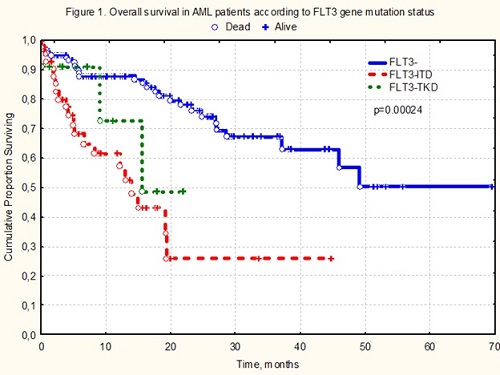
Contributions
Abstract: PB1682
Type: Publication Only
Background
Detection of FLT3 gene mutations in acute myeloid leukemia (AML) now recognized as an unfavorable factor that affects the disease course, emerging the risk of relapses and overall survival (OS) shortening. Although about 30% of AML patients harbor one of the FLT3 gene lesion, at present there are no internationally standardized assays to quantify FLT3 mutation burden and no results of randomized clinical trials intended to individualize AML treatment based on FLT3 status. Some hematologists advocate to allo-SCT as consolidation in FLT3 ITD+ patients, but this way could be hard in frail and old patients and in countries with low access to transplant techniques. On the other hand, the development of target drug therapy – FLT3-kinase inhibitors gives us a new hope for improvement in the treatment results of such poor-prognosis subset of AML patients.
Aims
To assess the frequency of FLT3 gene mutations and its impact on clinical parameters and overall survival of the patients with acute myeloid leukemia (AML) in routine clinical practice.
Methods
We have analyzed FLT3 gene mutation frequencies, complete blood count (CBC) parameters, karyotype and survival outcomes per FLT3-mutation status in 199 patients with AML (83 male / 116 female). The median age at diagnosis was 52 years (20-86 years). To determine FLT3 gene mutations we used the method of polymerase chain reaction (PCR) with subsequent restriction. FLT3 gene mutations were classified as internal tandem duplication (FLT3-ITD) and point mutation in the 'A-loop' (FLT3-TKD). Statistical analysis was included Kruskall-Wallis ANOVA and Kaplan-Meyer curves.
Results

Conclusion
We confirmed the role of FLT3 gene mutations as an unfavorable factor for AML patients in routine clinical practice by own experience. The investigation of qualitative assessment potential and target therapy value especially in SCT ineligible FLT3 gene mutations positive patients has of great value for AML management.
Session topic: 4. Acute myeloid leukemia - Clinical
Keyword(s): Practice, Flt3-ITD, FLT3, AML
Abstract: PB1682
Type: Publication Only
Background
Detection of FLT3 gene mutations in acute myeloid leukemia (AML) now recognized as an unfavorable factor that affects the disease course, emerging the risk of relapses and overall survival (OS) shortening. Although about 30% of AML patients harbor one of the FLT3 gene lesion, at present there are no internationally standardized assays to quantify FLT3 mutation burden and no results of randomized clinical trials intended to individualize AML treatment based on FLT3 status. Some hematologists advocate to allo-SCT as consolidation in FLT3 ITD+ patients, but this way could be hard in frail and old patients and in countries with low access to transplant techniques. On the other hand, the development of target drug therapy – FLT3-kinase inhibitors gives us a new hope for improvement in the treatment results of such poor-prognosis subset of AML patients.
Aims
To assess the frequency of FLT3 gene mutations and its impact on clinical parameters and overall survival of the patients with acute myeloid leukemia (AML) in routine clinical practice.
Methods
We have analyzed FLT3 gene mutation frequencies, complete blood count (CBC) parameters, karyotype and survival outcomes per FLT3-mutation status in 199 patients with AML (83 male / 116 female). The median age at diagnosis was 52 years (20-86 years). To determine FLT3 gene mutations we used the method of polymerase chain reaction (PCR) with subsequent restriction. FLT3 gene mutations were classified as internal tandem duplication (FLT3-ITD) and point mutation in the 'A-loop' (FLT3-TKD). Statistical analysis was included Kruskall-Wallis ANOVA and Kaplan-Meyer curves.
Results

Conclusion
We confirmed the role of FLT3 gene mutations as an unfavorable factor for AML patients in routine clinical practice by own experience. The investigation of qualitative assessment potential and target therapy value especially in SCT ineligible FLT3 gene mutations positive patients has of great value for AML management.
Session topic: 4. Acute myeloid leukemia - Clinical
Keyword(s): Practice, Flt3-ITD, FLT3, AML


